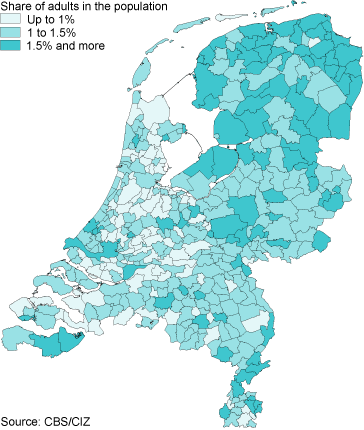More support for chronically ill, disabled and elderly people in the North and East of the Netherlands and Limburg than elsewhere

There were over 250 thousand chronically ill, disabled or elderly people in the Netherlands who required support in organising the practical matters of everyday life in 2012. This form of support without stay in a care institution is financed by the AWBZ (Exceptional Medical Expenses Act). It is most current in the northern and eastern provinces and Limburg.
Nearly 2 percent indication for support
In 2012 some 257 thousand adults who did not live in a care institution had an indication for support financed by the AWBZ. This comes down to 1.9 percent of the population aged over 18. Of these people, 149 thousand had an indication for individual support, 61 thousand for support in groups and 46 thousand for a combination of the two. Support is geared towards enabling elderly, chronically ill, or disabled people or people with chronic mental problems to live independently.
Regional differences
On 1 January 2015 the responsibility for supporting chronically ill, disabled and elderly people will be transferred from central government to the municipalities. It turns out that the share of adults requiring this type of care is above average in the northern and eastern parts of the Netherlands and in Limburg. For example: in 2012 the highest share of indications for individual support was found in Leeuwarden and Eemsmond (2.7 percent). In Muiden, fewer than half a percent of the adults had an indication for this. In Heerlen, 1.9 percent of the adults had an indication for group support. Vlieland had the lowest share for group support with 0.2 percent.
Adults with an indication for individual support per municipality, 2012

Lower share of support in small municipalities
A lower share of the adult population had an indication for support in small than in large municipalities. The share of people who had a right to receive individual support varied from 1 percent in municipalities with fewer than 10 thousand inhabitants to 1.7 percent in municipalities with between 150 thousand to 250 thousand inhabitants in 2012. The difference between small and large municipalities is less pronounced in group support.
Share of adults with an indication for support by municipal size 2012

Support especially for people with psychiatric problems
Psychiatric problems are often the reason to issue an indication for support. For instance, 40 percent of the indications for individual support and 28 percent of the indications for group support were issued to people with psychiatric problems. Furthermore about a quarter of the indications for both kinds of support was issued for physical, or somatic, problems.
Indications for support by type of problem 2012

Jurriën de Jong, Mirthe Bronsveld-De Groot, Onno van Hilten